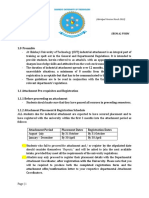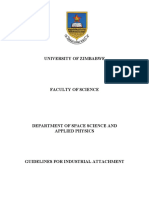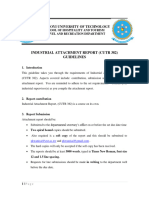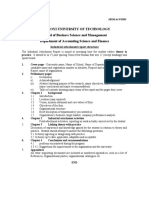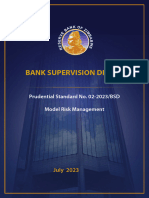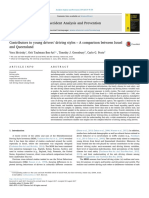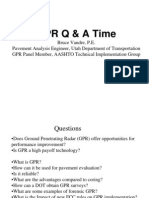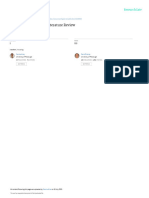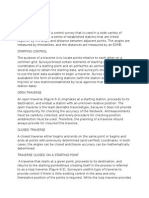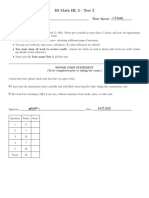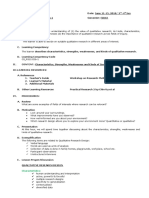NATIONAL UNIVERSITY OF SCIENCE AND TECHNOLOGY
FACULTY OF APPLIED SCIENCES
P O BOX AC939, ASCOT
BULAWAYO
TEL:
DEPARTMENT OF 09-
STATISTICS AND OPERATIONS RESEARCH
INDUSTRIAL ATTACHMENT GENERAL GUIDELINES
282842/288413/289557/28
9439
1. Introduction
It is a requirement that a student should go for Industrial attachment at a company/organization
where there is some application of Operations Research and /or Statistics. The purpose of
industrial attachment is for students to be able to apply the theory learnt at NUST and to acquire
extensive knowledge and skills.
2. Requirements
Four (4) copies of CV's that are well typed, justified alignment with no typos and no
grammatical errors.
List of companies in order of preference.
Contact email, cell, land and contact address.
3. Assessment
At least 2 assessment forms are to be filled in by the Industrial Supervisor (1 at the end
of first semester and the other at the end of second semester). This will be considered as
continuous assessment and will contribute 50% towards the overall mark.
2 copies of the Industrial Attachment Report must be submitted to the Department at a
date which shall be advised. This will contribute 40% towards the overall mark.
A 10 minute oral presentation done by the student at the final visit by the Academic
Supervisors after the Industrial Attachment Report has been marked. This presentation
may be presented as a Microsoft Power-point presentation. After the presentation the
student will be asked questions by the panel (Industrial and Academic Supervisors). This
will contribute 10% towards the overall mark.
Page 1
�4. Registration
The student is required to register for the First Semester before it begins and also for the Second
Semester before it begins.
NB. It is very crucial that the student takes note of the registration period, in particular the
deadlines so as to avoid any problems.
5. Period of Attachment
The Student should ideally be attached for a period of at least 8 months. An extension will be
agreed upon by the student and the company.
6. Arrival Form
Must be filled in and sent to the Department as soon as the student commences his/her
attachment. Once attached at a company the student will not be allowed to move to another
company unless in certain special circumstances. If a student does change companies without a
valid reason that student would have failed attachment.
7. Visits
The first visit will be in the First Semester and is a familiarization one, to check whether the
student has settled well, and to get to know the supervisor and to see what the student is doing.
The second visit is done in the Second Semester after the submission of the Industrial attachment
report by the student. The student is required to make a presentation for 10 minutes and
thereafter the student will be asked questions by the Industrial and Academic supervisors and
will be given a mark out of 10.
Page 2
�8. Industrial Attachment Report
Below are the guidelines on what to observe when you prepare your industrial attachment report,
the general structure and layout of the report write up and general typing considerations. The
report should contain three essential parts the preliminaries, the text and the reference section.
The Preliminaries: These include the Cover Page, Abstract, Acknowledgments, Table of
contents and List of Figures
The Cover Page should bear
Name of the Academic Institution
Name of the Institution/ Company where one is attached
Faculty Name
Name of Department
Student full names and registration number
The lower half of the page should read ‘Submitted in partial fulfillment of the
requirements for the BSc. Honours in Operations Research and Statistics’
Industrial & Academic Supervisors names
Month and year of submission
Abstract should
Broadly summarise the overall content of the report
Be brief and informative (should be at most one page)
Be single spaced
Acknowledgements
- These should be brief and concise
Table of contents
- It does list, in order everything included in the report, e.g. the titles of major divisions
and subdivisions exactly as they appear in the body of the write up, lists of tables and list
of figures.
List of tables, list of figures and Appendices
These should appear on separate pages
Page 3
�The Report main body: Includes the following chapters, Introduction, Attachment
Methodology, Application of Operations Research and Statistics in industry, Conclusions and
Recommendations
Chapter 1: Introduction
It should present the management structure and culture of the organisation, the important
features and developments in the industry /organisation, the product/service markets the
organisation operates in, the relationship between the organisation and the society.
Highlight general expectations when you joined the industry/organisation and the
difference between realities
Chapter 2: Attachment Methodology
It should contain a detailed report on the tasks done during the attachment period,
including any workshops, seminars or training attended. Highlight also how you
resolved any conflict between learning objectives and the need to carry out specific
duties. Include strength(s) and or weakness (es) during the attachment period.
Chapter 3: Application of Operations Research and Statistics in industry
It should present examples of how problems were tackled using skills acquired from
different elements of the degree programme. Include reports on mini projects done.
Mini project reports should have the following structure: title, problem definition, aim,
objectives, brief literature review, brief outline of methodology (ies) employed data
analysis, conclusions and recommendations.
Chapter 4: Conclusions and recommendations
Conclusions should be drawn logically from work done and presented.
Recommendations should be given to the industry/organisation/ and to the university on
how to handle unsolved aspects during attachment period. They may also include issues
on how to improve way of doing things. Also highlight how this one year work
experience will enhance the learning when you re-enter university for the final year of
study.
Page 4
�The Reference Section
References
The list of references should contain the bibliographic details of all works cited by the
writer. The list is in alphabetical order
Glossary (should appear just after the Table of contents)
It consists of lists and explanations of technical terms and symbols. The term in the
glossary are listed in alphabetic order.
Appendices
The appendix provides a place for material that would clutter the text. It may be placed
notes or methods, derivations, schedules, forms used in collecting data and illustrative
materials and tables of analysis.
Typing of the Report Document
The report must be well typed using Font style Times New Roman of size 12
Size A4 bond paper must be used and printing should be on one side of the page only
Double spacing form is preferred and the alignment should be Justified
There must be a margin of 40mm on the left-hand side of the page to allow for binding,
and a minimum of 10mm on the right hand side and 20 mm at the top and bottom of the
page
Pages should be numbered sequentially on the bottom of each page
9. Guidelines for Students
The student is subject to university and the company regulations during the industrial attachment.
The student is expected to:-
i. Conform to the company's regulations, working time and discipline.
ii. Fulfill the supervisor's instructions concerning the training process and carrying out of
the industrial research project.
Page 5
� iii. Write a log book on a daily basis and submit a report after finishing the training in a
given department (or training unit).
iv. Take part only with educational purpose in mind according to the ultimate instructions of
the supervisor.
v. put his/her best efforts to acquire extensive knowledge and skills in order to achieve
required standard of training.
vi. Keep good relations with all the staff of the company.
vii. Promote the good name of NUST.
10. Guidelines for the Industry
These are general guideline to the Industry on the treatment of the student during the industrial
attachment period.
i. The student will be subject to the company's regulations and is expected to function like a
full time employee of the company.
ii. The company is requested to provide the student with every opportunity to function like a
full time employee and permit him/her to actively participate in all aspects of the business
including management and administration except where confidentiality constraints may
not permit his/her participation.
iii. Wherever possible, the company is requested to assist the student by providing welfare
measures such as providing help in finding suitable accommodation close to the
company, access to canteen facilities, company transport facilities etc.
iv. If the company wishes to pay the student an extra allowance, the arrangement is only
between the two parties, that is the student and the company involved.
v. The student will be assessed and given a mark by the Industrial Supervisor towards the
end of each semester during the industrial attachment period.
11. Requirements for Industrial Attachment outside Zimbabwe
If a student wishes to be attached outside Zimbabwe the following are required:
(a) Application letter to the Chairperson of the Department.
Page 6
�(b) Company profile of the company you intend to join.
(c) Company acceptance letter addressed to the student
(d) Industrial supervisor’s curriculum vitae.
(e) Academic supervisor’s curriculum vitae.
(f) Student visa.
12. Carry over courses
A student cannot proceed to Part IV whilst carrying a Part I course. Students should make sure
they clear all their Part One courses.
There are two options:
A student can apply to use previous course work and write the exam and get a maximum
of a Pass (45%).
A student can write current tests and assignments and write the exam.
NB. Students should contact the Lecturer involved to make the necessary arrangements.
13. Part IV project
During the Industrial Attachment period, students should identify areas they can work on for
their final year project. They can easily get the data during attachment but they should follow the
correct channels and seek permission to use the data. Students should also find out about issues
of confidentiality from the company management.
14. Careers
Logistics, Inventory control, Operations management, Statistical Analysis, production planning,
planning and scheduling, transportation, routing and network design, market research and
survey, actuary, market analysis, financial analysis, research and product development,
derivatives trading, stock market.
NB. Students should regularly communicate with their Academic supervisors and the
Department.
Page 7











